tow CHEVROLET AVALANCHE 2007 2.G Owners Manual
[x] Cancel search | Manufacturer: CHEVROLET, Model Year: 2007, Model line: AVALANCHE, Model: CHEVROLET AVALANCHE 2007 2.GPages: 618, PDF Size: 3.25 MB
Page 1 of 618
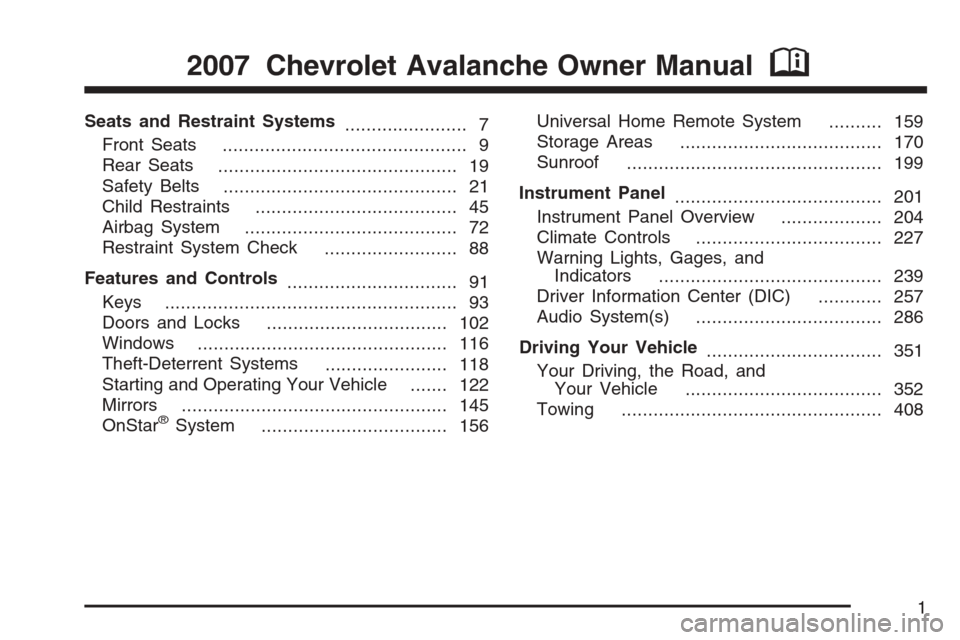
Seats and Restraint Systems
....................... 7
Front Seats
.............................................. 9
Rear Seats
............................................. 19
Safety Belts
............................................ 21
Child Restraints
...................................... 45
Airbag System
........................................ 72
Restraint System Check
......................... 88
Features and Controls
................................ 91
Keys
....................................................... 93
Doors and Locks
.................................. 102
Windows
............................................... 116
Theft-Deterrent Systems
....................... 118
Starting and Operating Your Vehicle
....... 122
Mirrors
.................................................. 145
OnStar
®System
................................... 156Universal Home Remote System
.......... 159
Storage Areas
...................................... 170
Sunroof
................................................ 199
Instrument Panel
....................................... 201
Instrument Panel Overview
................... 204
Climate Controls
................................... 227
Warning Lights, Gages, and
Indicators
.......................................... 239
Driver Information Center (DIC)
............ 257
Audio System(s)
................................... 286
Driving Your Vehicle
................................. 351
Your Driving, the Road, and
Your Vehicle
..................................... 352
Towing
................................................. 408
2007 Chevrolet Avalanche Owner ManualM
1
Page 19 of 618
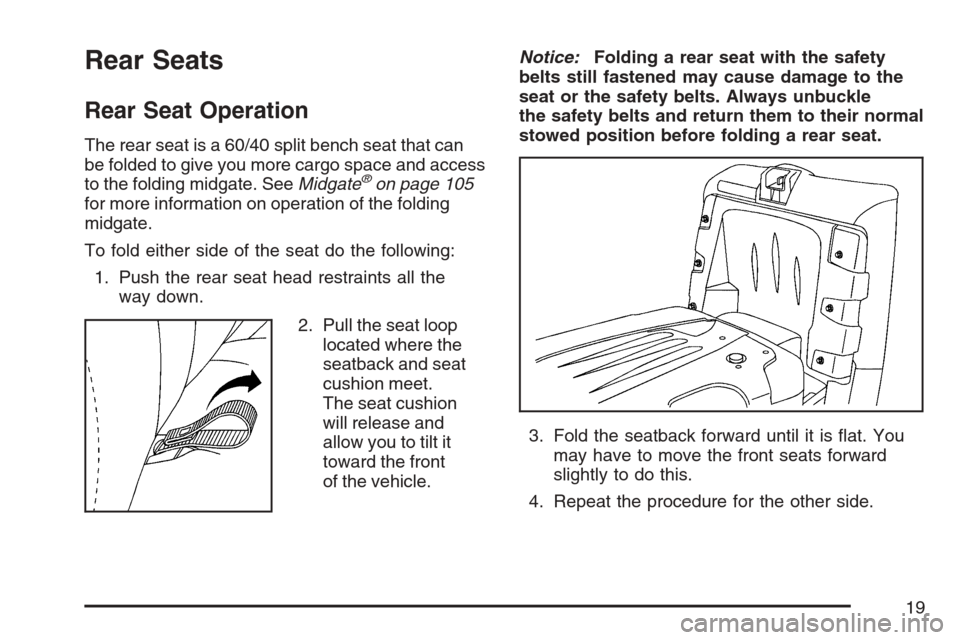
Rear Seats
Rear Seat Operation
The rear seat is a 60/40 split bench seat that can
be folded to give you more cargo space and access
to the folding midgate. SeeMidgate
®on page 105
for more information on operation of the folding
midgate.
To fold either side of the seat do the following:
1. Push the rear seat head restraints all the
way down.
2. Pull the seat loop
located where the
seatback and seat
cushion meet.
The seat cushion
will release and
allow you to tilt it
toward the front
of the vehicle.Notice:Folding a rear seat with the safety
belts still fastened may cause damage to the
seat or the safety belts. Always unbuckle
the safety belts and return them to their normal
stowed position before folding a rear seat.
3. Fold the seatback forward until it is �at. You
may have to move the front seats forward
slightly to do this.
4. Repeat the procedure for the other side.
19
Page 46 of 618
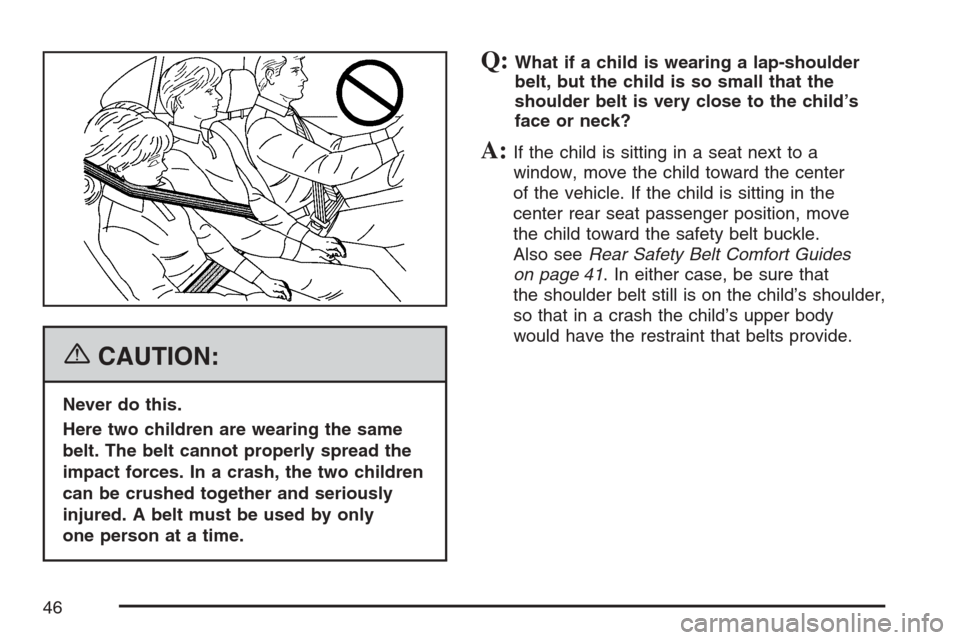
{CAUTION:
Never do this.
Here two children are wearing the same
belt. The belt cannot properly spread the
impact forces. In a crash, the two children
can be crushed together and seriously
injured. A belt must be used by only
one person at a time.
Q:What if a child is wearing a lap-shoulder
belt, but the child is so small that the
shoulder belt is very close to the child’s
face or neck?
A:If the child is sitting in a seat next to a
window, move the child toward the center
of the vehicle. If the child is sitting in the
center rear seat passenger position, move
the child toward the safety belt buckle.
Also seeRear Safety Belt Comfort Guides
on page 41. In either case, be sure that
the shoulder belt still is on the child’s shoulder,
so that in a crash the child’s upper body
would have the restraint that belts provide.
46
Page 51 of 618
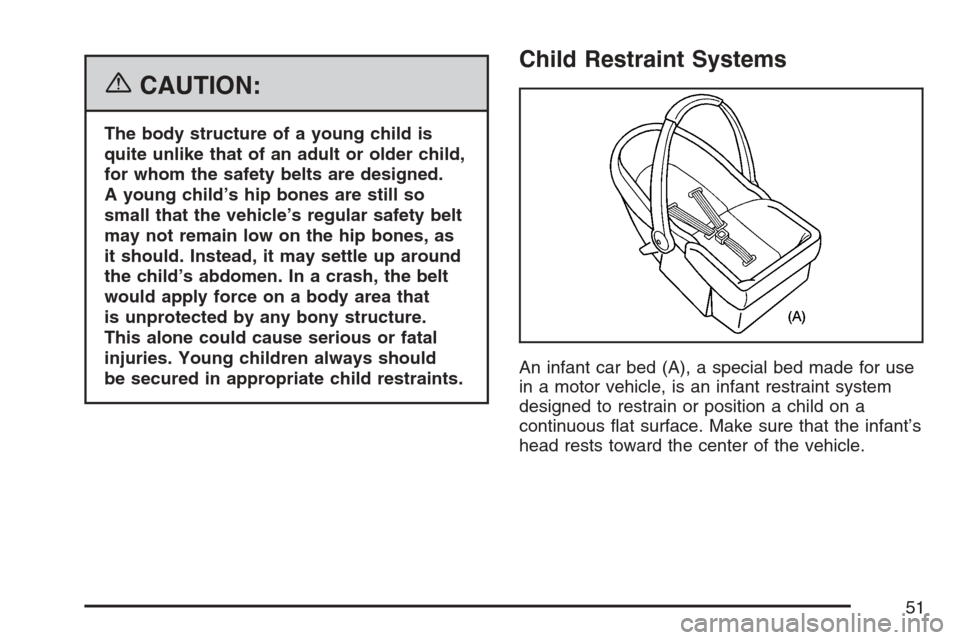
{CAUTION:
The body structure of a young child is
quite unlike that of an adult or older child,
for whom the safety belts are designed.
A young child’s hip bones are still so
small that the vehicle’s regular safety belt
may not remain low on the hip bones, as
it should. Instead, it may settle up around
the child’s abdomen. In a crash, the belt
would apply force on a body area that
is unprotected by any bony structure.
This alone could cause serious or fatal
injuries. Young children always should
be secured in appropriate child restraints.
Child Restraint Systems
An infant car bed (A), a special bed made for use
in a motor vehicle, is an infant restraint system
designed to restrain or position a child on a
continuous �at surface. Make sure that the infant’s
head rests toward the center of the vehicle.
51
Page 62 of 618
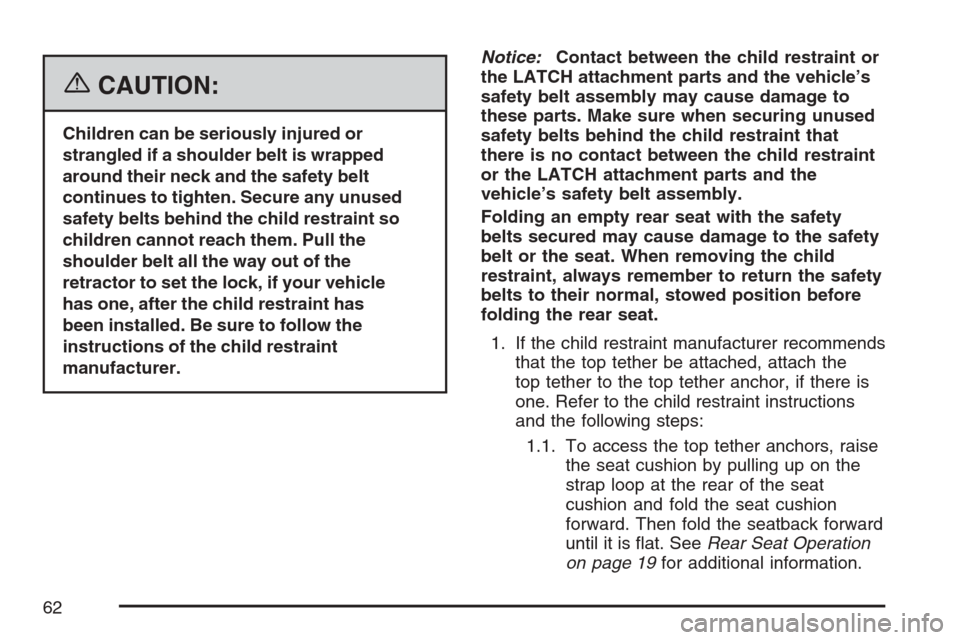
{CAUTION:
Children can be seriously injured or
strangled if a shoulder belt is wrapped
around their neck and the safety belt
continues to tighten. Secure any unused
safety belts behind the child restraint so
children cannot reach them. Pull the
shoulder belt all the way out of the
retractor to set the lock, if your vehicle
has one, after the child restraint has
been installed. Be sure to follow the
instructions of the child restraint
manufacturer.Notice:Contact between the child restraint or
the LATCH attachment parts and the vehicle’s
safety belt assembly may cause damage to
these parts. Make sure when securing unused
safety belts behind the child restraint that
there is no contact between the child restraint
or the LATCH attachment parts and the
vehicle’s safety belt assembly.
Folding an empty rear seat with the safety
belts secured may cause damage to the safety
belt or the seat. When removing the child
restraint, always remember to return the safety
belts to their normal, stowed position before
folding the rear seat.
1. If the child restraint manufacturer recommends
that the top tether be attached, attach the
top tether to the top tether anchor, if there is
one. Refer to the child restraint instructions
and the following steps:
1.1. To access the top tether anchors, raise
the seat cushion by pulling up on the
strap loop at the rear of the seat
cushion and fold the seat cushion
forward. Then fold the seatback forward
until it is �at. SeeRear Seat Operation
on page 19for additional information.
62
Page 79 of 618
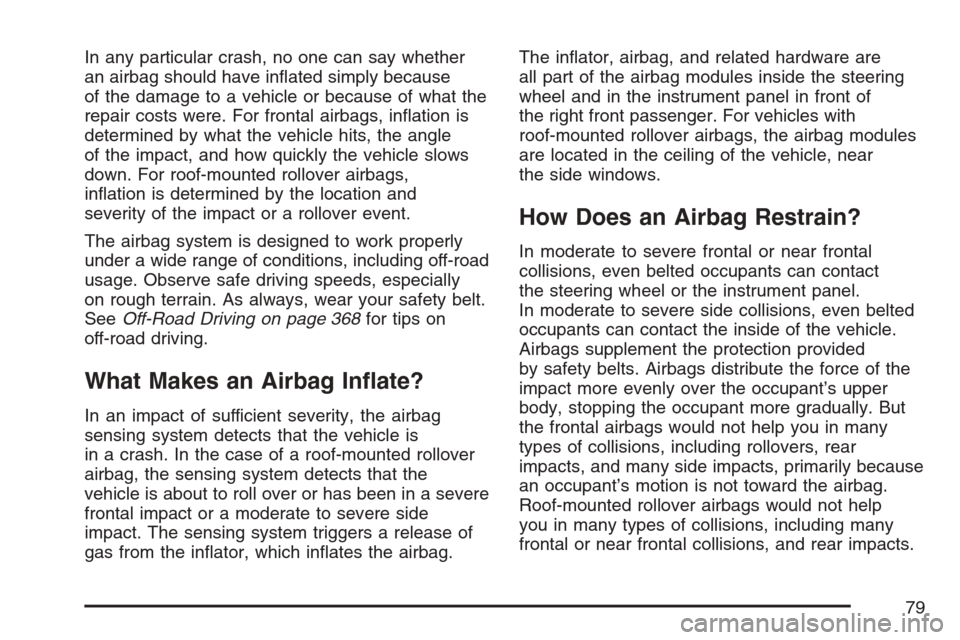
In any particular crash, no one can say whether
an airbag should have in�ated simply because
of the damage to a vehicle or because of what the
repair costs were. For frontal airbags, in�ation is
determined by what the vehicle hits, the angle
of the impact, and how quickly the vehicle slows
down. For roof-mounted rollover airbags,
in�ation is determined by the location and
severity of the impact or a rollover event.
The airbag system is designed to work properly
under a wide range of conditions, including off-road
usage. Observe safe driving speeds, especially
on rough terrain. As always, wear your safety belt.
SeeOff-Road Driving on page 368for tips on
off-road driving.
What Makes an Airbag In�ate?
In an impact of sufficient severity, the airbag
sensing system detects that the vehicle is
in a crash. In the case of a roof-mounted rollover
airbag, the sensing system detects that the
vehicle is about to roll over or has been in a severe
frontal impact or a moderate to severe side
impact. The sensing system triggers a release of
gas from the in�ator, which in�ates the airbag.The in�ator, airbag, and related hardware are
all part of the airbag modules inside the steering
wheel and in the instrument panel in front of
the right front passenger. For vehicles with
roof-mounted rollover airbags, the airbag modules
are located in the ceiling of the vehicle, near
the side windows.
How Does an Airbag Restrain?
In moderate to severe frontal or near frontal
collisions, even belted occupants can contact
the steering wheel or the instrument panel.
In moderate to severe side collisions, even belted
occupants can contact the inside of the vehicle.
Airbags supplement the protection provided
by safety belts. Airbags distribute the force of the
impact more evenly over the occupant’s upper
body, stopping the occupant more gradually. But
the frontal airbags would not help you in many
types of collisions, including rollovers, rear
impacts, and many side impacts, primarily because
an occupant’s motion is not toward the airbag.
Roof-mounted rollover airbags would not help
you in many types of collisions, including many
frontal or near frontal collisions, and rear impacts.
79
Page 85 of 618
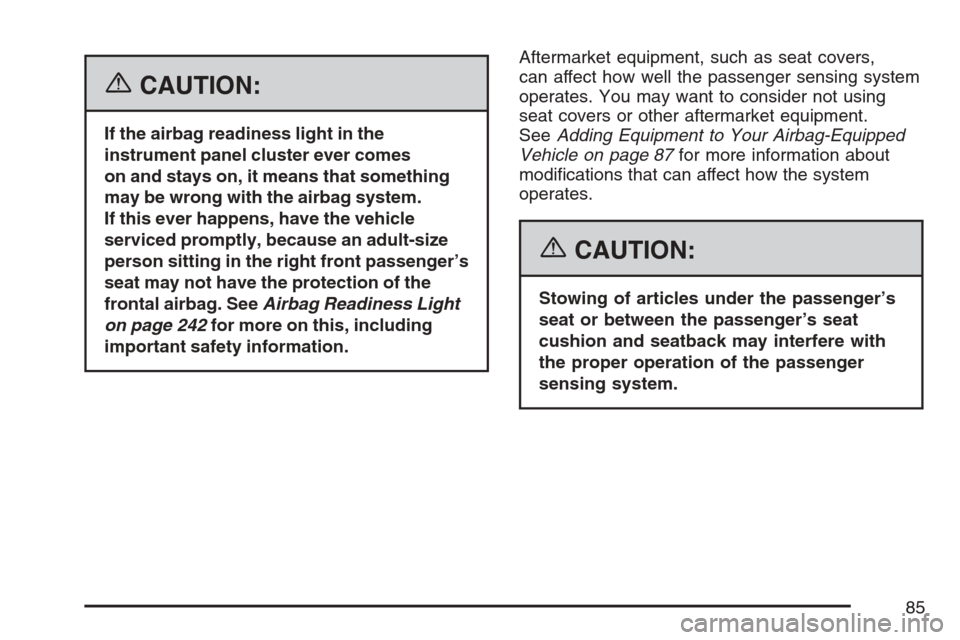
{CAUTION:
If the airbag readiness light in the
instrument panel cluster ever comes
on and stays on, it means that something
may be wrong with the airbag system.
If this ever happens, have the vehicle
serviced promptly, because an adult-size
person sitting in the right front passenger’s
seat may not have the protection of the
frontal airbag. SeeAirbag Readiness Light
on page 242for more on this, including
important safety information.Aftermarket equipment, such as seat covers,
can affect how well the passenger sensing system
operates. You may want to consider not using
seat covers or other aftermarket equipment.
SeeAdding Equipment to Your Airbag-Equipped
Vehicle on page 87for more information about
modi�cations that can affect how the system
operates.
{CAUTION:
Stowing of articles under the passenger’s
seat or between the passenger’s seat
cushion and seatback may interfere with
the proper operation of the passenger
sensing system.
85
Page 91 of 618
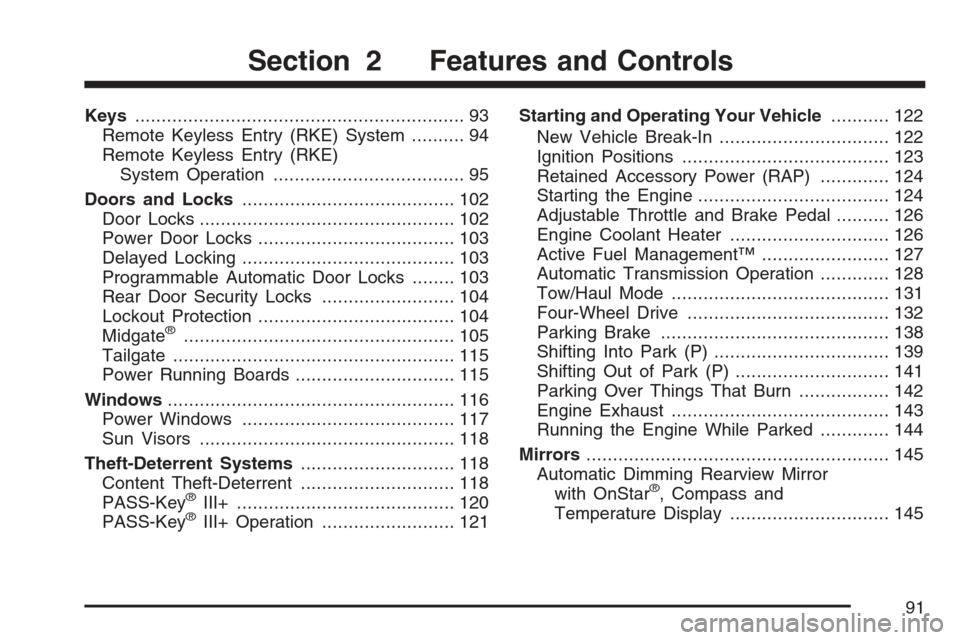
Keys.............................................................. 93
Remote Keyless Entry (RKE) System.......... 94
Remote Keyless Entry (RKE)
System Operation.................................... 95
Doors and Locks........................................ 102
Door Locks................................................ 102
Power Door Locks..................................... 103
Delayed Locking........................................ 103
Programmable Automatic Door Locks........ 103
Rear Door Security Locks......................... 104
Lockout Protection..................................... 104
Midgate
®................................................... 105
Tailgate..................................................... 115
Power Running Boards.............................. 115
Windows...................................................... 116
Power Windows........................................ 117
Sun Visors................................................ 118
Theft-Deterrent Systems............................. 118
Content Theft-Deterrent............................. 118
PASS-Key
®III+......................................... 120
PASS-Key®III+ Operation......................... 121Starting and Operating Your Vehicle........... 122
New Vehicle Break-In................................ 122
Ignition Positions....................................... 123
Retained Accessory Power (RAP)............. 124
Starting the Engine.................................... 124
Adjustable Throttle and Brake Pedal.......... 126
Engine Coolant Heater.............................. 126
Active Fuel Management™........................ 127
Automatic Transmission Operation............. 128
Tow/Haul Mode......................................... 131
Four-Wheel Drive...................................... 132
Parking Brake........................................... 138
Shifting Into Park (P) ................................. 139
Shifting Out of Park (P)............................. 141
Parking Over Things That Burn................. 142
Engine Exhaust......................................... 143
Running the Engine While Parked............. 144
Mirrors......................................................... 145
Automatic Dimming Rearview Mirror
with OnStar
®, Compass and
Temperature Display.............................. 145
Section 2 Features and Controls
91
Page 108 of 618
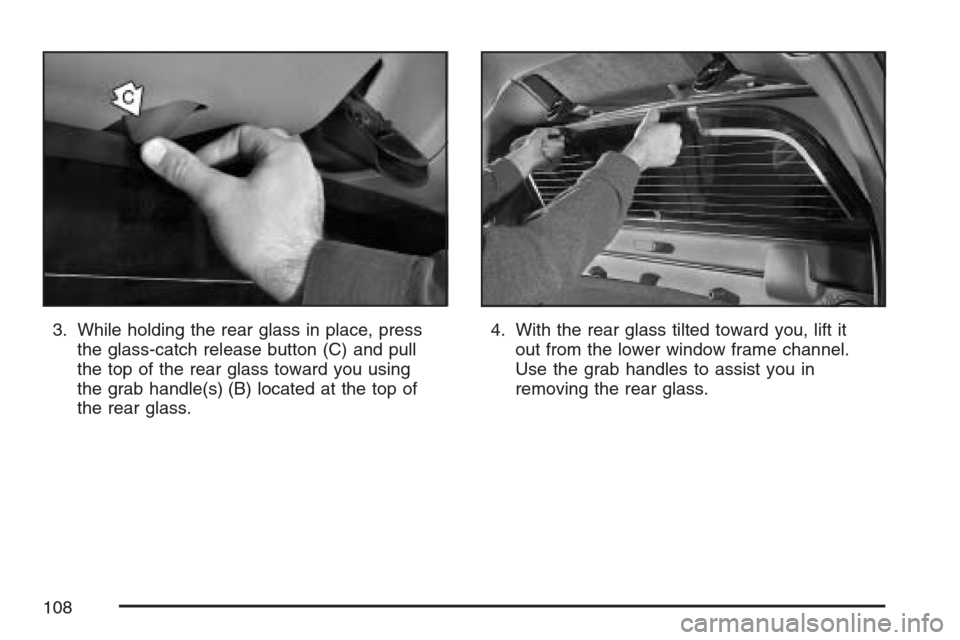
3. While holding the rear glass in place, press
the glass-catch release button (C) and pull
the top of the rear glass toward you using
the grab handle(s) (B) located at the top of
the rear glass.4. With the rear glass tilted toward you, lift it
out from the lower window frame channel.
Use the grab handles to assist you in
removing the rear glass.
108
Page 113 of 618
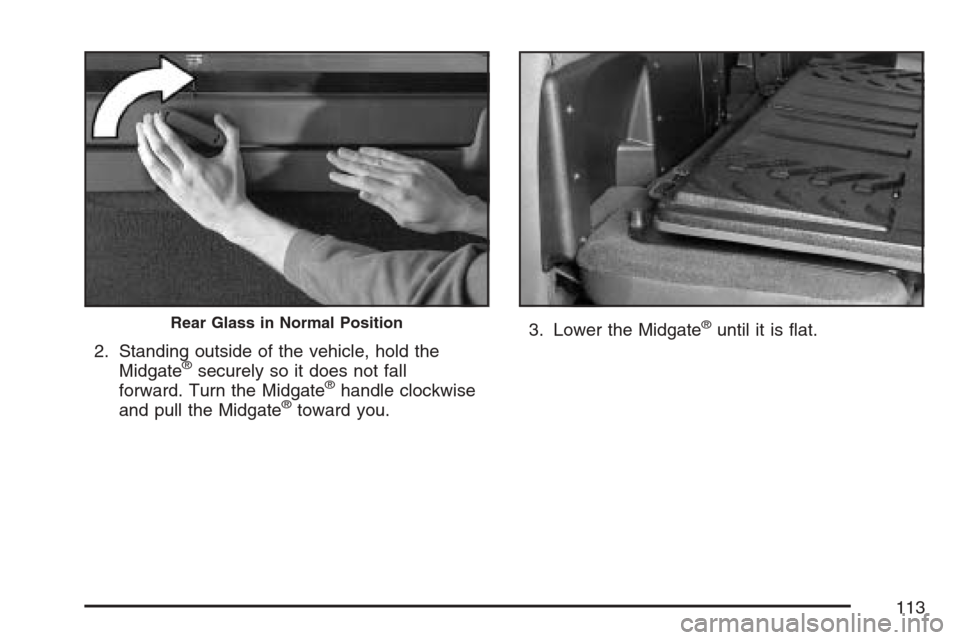
2. Standing outside of the vehicle, hold the
Midgate®securely so it does not fall
forward. Turn the Midgate®handle clockwise
and pull the Midgate®toward you.3. Lower the Midgate
®until it is �at.Rear Glass in Normal Position
113